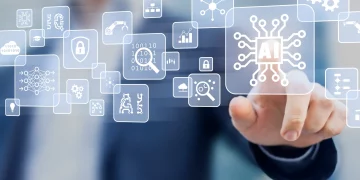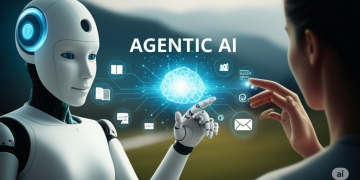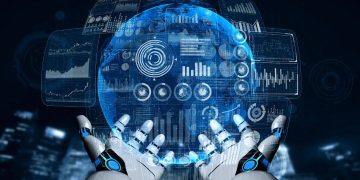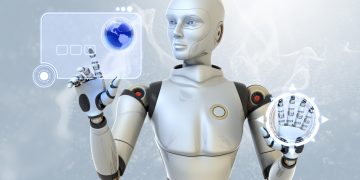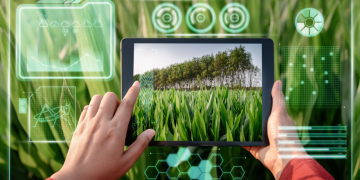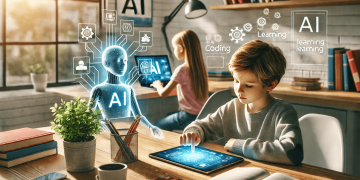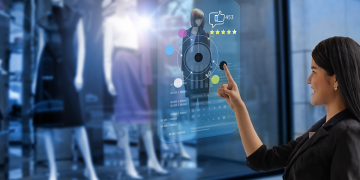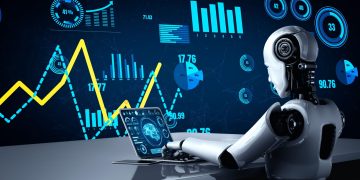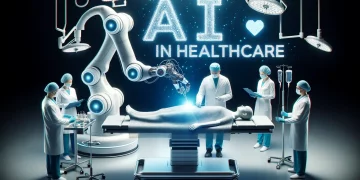Introduction:
Agriculture has been the foundation of human civilization for thousands of years, providing food, raw materials, and economic stability to societies across the world. As the global population continues to grow, and the effects of climate change and environmental degradation intensify, the pressure on agricultural systems to produce more with fewer resources has never been greater. At the same time, there is increasing demand for sustainable farming practices that preserve the environment, conserve water, and reduce waste.
Artificial Intelligence (AI) is emerging as a powerful tool in the agricultural sector, offering solutions to many of these challenges. From enhancing crop yields and reducing environmental impact to optimizing resource use and improving decision-making processes, AI technologies are transforming the agricultural landscape. AI enables farmers to monitor crops in real-time, predict weather patterns, manage irrigation efficiently, and detect diseases early, all while ensuring that farming practices remain environmentally sustainable.
This article will explore how AI is revolutionizing agriculture by increasing crop yields and contributing to sustainable development. We will look at the technologies driving this transformation, their applications in farming, and the challenges that need to be addressed to ensure the widespread adoption of AI in agriculture.
1. The Role of AI in Enhancing Agricultural Productivity
Agricultural productivity has always been a key focus for farmers, as it directly impacts the yield of crops and the economic viability of farms. However, traditional farming methods are often inefficient, resource-intensive, and susceptible to environmental factors. AI is playing a central role in enhancing productivity by providing tools for precision farming, monitoring crop health, and optimizing resource use.
1.1 Precision Farming: The Intersection of AI and Data
Precision farming refers to the use of technology to monitor and manage the variability of crops and soil within a field, with the goal of improving both crop yields and sustainability. AI is at the heart of precision agriculture, helping farmers make data-driven decisions and optimize their farming practices.
- Data Collection and Analysis: AI technologies like sensors, drones, and satellites collect massive amounts of data about the soil, weather, and crop conditions. AI systems process this data to generate actionable insights. For example, AI can analyze soil composition to determine the best crops to plant and suggest the right amount of fertilizer.
- Variable Rate Technology (VRT): AI algorithms enable VRT systems to adjust inputs such as water, fertilizer, and pesticides based on the specific needs of different parts of a field. This reduces waste and minimizes environmental impact while ensuring that crops receive the right amount of resources to thrive.
1.2 AI in Crop Monitoring and Disease Detection
Monitoring crop health is critical to ensuring high yields. AI has proven to be invaluable in detecting early signs of disease, pests, and nutrient deficiencies, allowing farmers to take timely action and prevent crop losses.
- Machine Vision and Image Recognition: Drones and cameras equipped with AI-powered machine vision software can analyze plant images to identify early signs of diseases, pest infestations, and nutrient deficiencies. These systems use image recognition algorithms to spot visual anomalies, such as discoloration or wilting, and alert farmers to potential issues.
- Predictive Analytics for Disease and Pest Management: AI systems can predict pest infestations and disease outbreaks by analyzing historical data and environmental factors. For example, AI can identify the conditions that typically lead to the proliferation of a specific pest or pathogen and provide early warnings to farmers.
1.3 Optimizing Water and Fertilizer Use
Water and fertilizers are two of the most important resources in agriculture, yet they are often used inefficiently. AI can help farmers optimize their use to reduce waste, lower costs, and minimize environmental impact.
- Smart Irrigation Systems: AI-powered irrigation systems use weather data, soil moisture levels, and crop requirements to deliver the right amount of water at the right time. These systems prevent over-irrigation, saving water and reducing the risk of soil erosion or nutrient runoff.
- AI-Driven Fertilizer Application: By analyzing soil health data and crop needs, AI can recommend the optimal amount of fertilizer for each part of a field, reducing the overuse of chemicals and preventing soil degradation.
2. AI and Sustainable Agricultural Practices
Sustainability has become a central concern in modern agriculture. The need to increase food production while conserving natural resources and protecting the environment is driving innovation in sustainable farming practices. AI is playing a crucial role in supporting sustainability by enabling more efficient use of resources, reducing waste, and minimizing the environmental footprint of farming activities.
2.1 Reducing Environmental Impact through AI
Agricultural practices, particularly conventional farming, often lead to deforestation, soil depletion, water pollution, and greenhouse gas emissions. AI offers solutions that help mitigate these environmental impacts and contribute to more sustainable farming practices.
- AI and Reduced Chemical Use: AI-driven precision farming techniques help reduce the need for pesticides and herbicides. By applying chemicals only when necessary, farmers can limit the environmental impact of these substances on surrounding ecosystems.
- Sustainable Crop Rotation and Diversification: AI can analyze soil health and recommend crop rotation strategies that improve soil fertility and reduce the likelihood of pests and diseases. Crop diversification strategies powered by AI also contribute to ecological balance and better land management.
2.2 Resource Efficiency and Waste Reduction
AI technologies enable farmers to optimize the use of water, energy, and labor, leading to significant resource savings.
- Energy Efficiency in Greenhouses: AI can optimize environmental conditions in greenhouses by adjusting temperature, humidity, and lighting to match the specific needs of plants. This reduces energy consumption and helps create a more sustainable food production system.
- Waste Reduction in Harvesting: AI-powered robots and automation can reduce waste during the harvesting process by accurately detecting ripe crops and ensuring that they are picked at the optimal time. This minimizes food loss and maximizes the yield per acre.
2.3 AI in Carbon Sequestration and Climate Change Mitigation
AI can also help agriculture contribute to climate change mitigation by enhancing carbon sequestration in soils and forests. Through AI, farmers can monitor soil carbon levels, optimize land management practices, and reduce emissions associated with farming activities.
- AI in Carbon Farming: AI can assist farmers in implementing carbon farming techniques, such as planting cover crops and optimizing grazing practices, which help sequester carbon in the soil.
- Climate-Resilient Crop Development: AI technologies, including machine learning and genomics, are used to develop climate-resilient crops that can withstand extreme weather events, drought, and changing climate conditions, thereby ensuring food security in the face of climate change.

3. AI-Driven Automation in Agriculture
One of the most significant trends in agriculture is the rise of automation, driven by AI technologies. From autonomous tractors to drones and harvesting robots, AI-powered automation is transforming the labor landscape in farming and improving operational efficiency.
3.1 Autonomous Tractors and Harvesters
Autonomous vehicles are revolutionizing farming by reducing the need for human labor and improving efficiency in tasks such as plowing, planting, and harvesting.
- Self-Driving Tractors: AI-powered tractors can plow fields, plant seeds, and apply fertilizers without human intervention. These autonomous machines use GPS, sensors, and AI algorithms to navigate fields accurately, increasing the speed and precision of these tasks while reducing labor costs.
- Automated Harvesting: AI-driven harvesting robots are designed to detect and pick ripe crops with minimal damage, improving yield quality and reducing labor requirements.
3.2 Robotics and Drones for Field Monitoring
Drones and robotics have become indispensable tools in modern agriculture, providing farmers with real-time insights into field conditions.
- Crop Surveillance: AI-powered drones equipped with cameras and sensors fly over fields to monitor crop health, soil moisture, and overall growth. This provides farmers with a bird’s-eye view of their fields and allows them to make timely adjustments to farming practices.
- Robotic Weeding and Planting: Robotics driven by AI can automate tasks such as weeding, planting, and pruning, reducing the need for chemicals and minimizing soil disturbance.
4. Challenges and Barriers to AI Adoption in Agriculture
While AI offers numerous benefits for agriculture, its adoption is not without challenges. These challenges need to be addressed to ensure the widespread and effective use of AI in farming.
4.1 Access to Technology and Expertise
Many farmers, particularly those in developing regions, face barriers to accessing AI technologies. Limited access to high-speed internet, computing infrastructure, and technical expertise can hinder the adoption of AI in agriculture.
- Digital Divide: Farmers in rural areas often lack the necessary infrastructure to access AI-powered tools. Bridging the digital divide is essential for ensuring that AI benefits are accessible to all farmers, regardless of their location.
- Training and Education: To effectively use AI technologies, farmers need training in how to operate and interpret AI systems. Providing accessible educational resources and support is crucial for successful AI integration.
4.2 Cost of Implementation
The cost of adopting AI technologies can be a significant barrier for small-scale farmers. The initial investment required for AI systems, sensors, drones, and other equipment can be prohibitive for many.
- Affordability: While AI offers long-term cost savings, the upfront costs of implementing AI in agriculture may be too high for many small farmers. Finding ways to reduce costs and make these technologies more affordable is essential for wider adoption.
4.3 Data Privacy and Security
AI in agriculture relies heavily on data collection from fields, sensors, and other sources. Protecting the privacy and security of this data is a critical concern.
- Data Ownership: Farmers must have control over the data generated by their operations, and regulations need to be in place to protect their privacy and ensure the ethical use of agricultural data.
- Cybersecurity Risks: As agriculture becomes increasingly digital, the risk of cyberattacks on AI systems grows. Ensuring that data and systems are secure from malicious attacks is essential for building trust in AI technologies.
5. The Future of AI in Agriculture
The future of AI in agriculture looks promising, with continued advancements in technology and its integration into farming practices. AI has the potential to revolutionize food production, making it more efficient, sustainable, and resilient to climate change.
- AI-Enhanced Supply Chains: AI will help optimize global food supply chains by improving traceability, reducing waste, and increasing the efficiency of food distribution.
- Genomic Breeding and AI-Driven Crop Improvement: The future of AI in agriculture will likely involve genetic modification and AI-driven breeding programs to create crops that are more resilient to climate stress, pests, and diseases.
Conclusion
Artificial intelligence has the potential to transform agriculture by increasing crop yields, improving resource use efficiency, and promoting sustainability. As AI technologies continue to evolve, they will play a key role in shaping the future of farming, ensuring that the agriculture industry can meet the growing demands of a global population while minimizing its environmental impact. However, addressing challenges such as access to technology, cost, and data privacy will be critical to ensuring that the benefits of AI are accessible to all farmers.





